This is the second blog post I’ve published in a short time, so if you don’t check my blog religiously (as you should) you may have missed the first one. It’s called “First Week of Class”, and if you haven’t read it, you should check it out. It’s an epic saga of courage and excitement. You should go ahead and click the ‘previous post’ button now.
Haha, they’re gone, off reading that snoozefest called “First Week of Class”. Don’t worry, folks, there’ll be lots of cool stuff going on in this post, and plenty of pictures as well; all of them lovingly uploaded through a low-grade wireless connection bogged down by a half a dozen lonely college students videoconferencing on Skype. So sit back and enjoy this obscenely massive, picture-riddled blogstravaganza.
Last weekend, we went on a class excursion to Kerry, a county in the far southwestern region of Ireland. (Actually, the term ‘weekend’ is a bit misleading; in this case, our weekend started on Wednesday afternoon.) We left at 9:00 in the morning on Thursday, and we would return to the Park Lodge on Sunday evening.
Our bus driver, unfortunately, wasn’t as entertaining as our previous tour guide. He had a strong accent, which made him hard to understand. That was okay, though, because he almost never had anything interesting to say.
There’s only one large attraction between Galway and Kerry. And it’s a big one: The Cliffs of Mohr. The word Mohr is Gaelic for “Big”, and in this case, the Gaelic was entirely accurate.
The Cliffs of Mohr stretch for about five miles, jutting in and out of the landscape in the wonderfully picturesque fashion you see here. Of course, when tourism started on the Cliffs, a large number of foolish Americans died when they were blown over the cliffedge. The helpful Irish government put up some barriers and signs to lower the death toll.
As good world citizens, we obeyed these warnings and provisions to the letter.
Anyway, after we’d covered the Cliffs of Mohr, it was time to continue to our final destination: the town of Tralee in County Kerry. We stopped at a couple of places before reaching Tralee, namely the Castle Dunguare (which was a tourist trap) and the town of Waterville, which boasted a beautiful beach and a charioteer. That’s right, I said a charioteer.
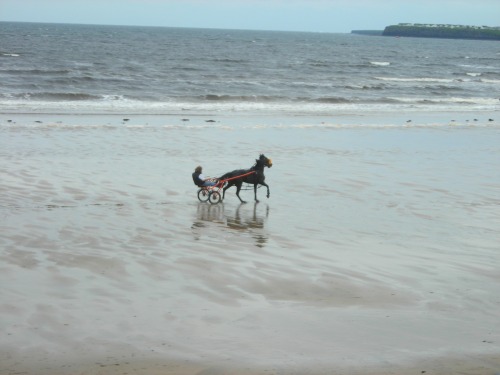
This guy was just flying across the beach. There are a lot of horses in Ireland; not because they are useful, but because the government gives a tax break to anyone who keeps a horse on their land. It's part of their campaign to preserve the Irish culture.
After these diversions, it was off to Tralee. We stayed in Finnegan’s Hostel, right on main street. It was my first hostel experiance, and I was duely impressed. We had breakfast served to us every morning and unlimited hot showers and clean towels. So in a lot of ways, it was nicer than the cottage. Except, of course, that we slept 12 guys to one room, which was a bit of a challege.
Of course, as soon as we got off the bus, it was time to begin a crazy night of partying. It was the 21st birthday of one of our group members, so we all went out to celebrate. I ate traditional Irish stew at a pub, which was the best meal I’ve had so far, and the best price. The partying got a little out of hand that night, mostly because the birthday boy got pretty drunk. But there are strict closing times imposed on all the pubs in Ireland: 11:30 on weekdays, 12:30 on weekends. So we still got back to the hostel in time to get some sleep. Which was good, because we had to get up bright and early to drive to the Ring of Kerry.
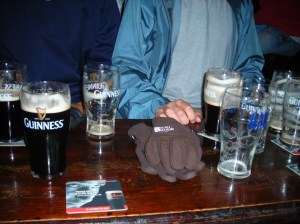
That's the birthday boy on the right. On the left is actually my first pint of Guiness, which someone gave me. It was a bit heavy for a newbie such as myself, so I didn't care when someone stole it.
The Ring of Kerry is a 120 mile circle of scenic roadway. I’d read the guidebook on the Ring of Kerry, and I was pretty excited. I knew there were 3 ancient ring forts on the trip, much like the one I’d been to on Inis Mor, and I was looking forward to seeing them. Unfortunately, our driver had other ideas. He seemed to follow a tour better suited for the 60 year old Americans that he usually takes. We stopped at little touristy shops and villages, and completely skipped all the ring forts. The sole high point of the tour was when we stopped at a scenic overlook about halfway around the Ring. We’d just passed the first ring fort, so I wanted to get a picture of that.
Then I noticed that some of our group had started hiking up a nearby mountain. At this point, I’d been sitting in a bus for several hours, so climbing a mountain seemed like an awfully good idea. It turned out to be a high point of the weekend.
It was exhausting, mostly because I didn’t mess around with switchbacks or rest breaks, or any of the other things sensible hikers do. I just kind of charged straight up. Our program director, Chuck, was probably a little confused as well, because no one had told him about what we were doing, or how long it was likely to take us.
The climb took a good 20 minutes (it wasn’t really all that far, just steep). I took a lot of pictures on this hike, mostly because the view only got better and better as I climbed. As we ascended higher and higher, the hill became shrouded in the mist that always seems to hover around the tops of Irish mountains. Here’s what it looked like from the top.
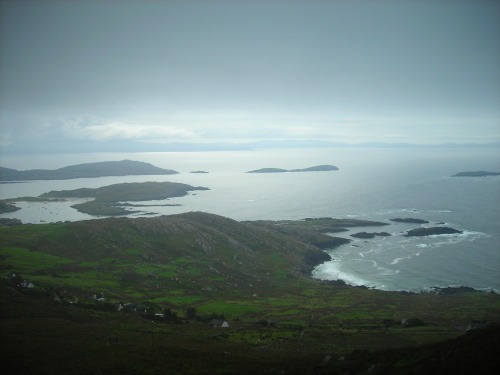
I probably photographed this stretch of ocean a dozen times. But none of the pictures really show how amazing it looked at the top of that mountain.
After a while, we got back on the road. The Ring of Kerry was very scenic, but after a week in Ireland we’d all become rather jaded to the beautiful Irish landscape. We wanted to get out and do things, like climb a mountain, not just look out the window of the bus. But the rest of the tour passed without doing anything of interest.
The last event of the day was a tour of the Muckross Estate. Like Dingle, this was a terrible name for a very cool place. The Muckross Estate is a wonderful example of Victorian overindulgence: It’s an incredibly large house set in the Irish countryside on a large wooded estate. The Muckross family lived there in luxury for the better part of a hundred years. Here’s a picture of the house.
Photos were prohibited inside the house, which is too bad, because the first room had the coolest thing. It was the entrance hall, and it was ringed with the skulls of prized deer that had been shot by hunters in the estate. But the prized piece was the antlers of an Ancient Irish deer, recovered from a bog by one of the Muckrosses. 10,000 years ago there lived a species of deer specific to Ireland. It was enormous: it could stand nine feet tall, with a spread of antlers over six feet wide. I wish I could have photographed the set of antlers in the Muckross House. I could have easily laid down inside them. Anywya, here’s a photo of an Irish deer, courtesy of our good friend The Internet.
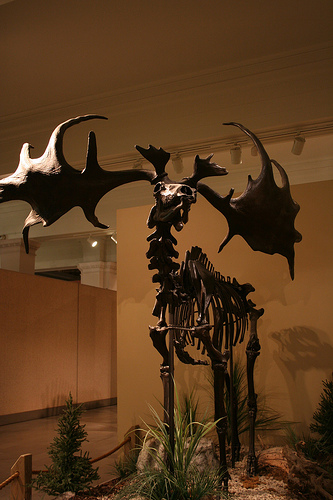
Can you imagine, having this thing running at you, and all you have is a stone spear? I would need a new loincloth after that encounter.
The rest of the house was massive. Simply massive. There were 25 bedrooms in the estate, not counting the ones where the 22 servants slept. Every piece of furnature was either guilded or hand carved, or both. One neat feature of the house was a set of 32 bells in the servant’s quarters. Each bell was attached by wires to a different room of the house. Whenever a house guest rang the bell, a servant could tell which one was ringing by the tone of the bell, and thus which room to report to.
The reason for the downfall of the Muckross family is sort of poetic, really. Queen Victoria announced that she would be spending two days with the Muckross family when she visited Ireland. She gave them six year’s warning. The Muckross family were looking to obtain a title from the Queen, so they spent a vast sum of money improving the household. Italian drapes were commissioned, new furnature and carpet were ordered, rooms were redone, all for the sake of a two day engagement with the Queen. Anyway, Victoria visited, and her stay went well. While the Muckrosses were waiting for their title, which was a common reward for a pleasant stay, her husband Albert died. The Queen went into mourning, forgot all about the Muckrosses, and the Muckrosses lost everything to their incredible debts.
After the tour, we went to walk around on the estate grounds, which were every bit as impressive as the interior.
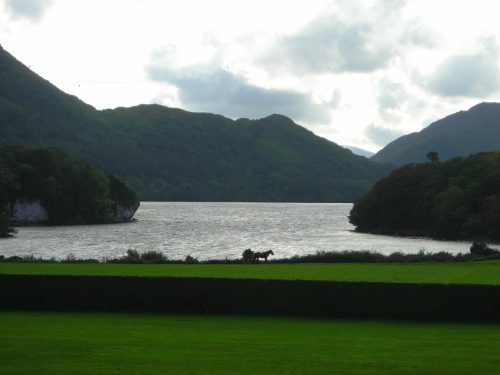
Can you imagine waking up to this view every morning? As I went to snap this photo, a horse and carriage drove by, just to make it a little more perfect.
That evening at the hostel was a little more subdued than the previous one. No one had the energy (or the money) for another night like Thursday night. I didn’t even head straight to the pub. Instead, I went to an internet shop with a friend. He was feeling a little homesick, and wanted to do some Skyping (for those of you not hip to Skype, it’s a kind of internet phone service that can be used to make cheap calls to anywhere.) I didn’t have anything better to do, so I went along, as did another friend.
I’m not really sure if ‘internet shop’ is the right word for where we went, because there’s really no paralell for it in America. It was a seedy little room lined with computers and Skype headsets. It was run by an Indian man who would charge you 2EU for an hour online. I picked out a computer and checked my email while my friend called his family.
It was here that I recieved an email from my father, telling of the passing of my grandfather, Virgil Antony. Grandpa Virg had been fighting a long battle with pancreatic cancer, and now it was finally time. He was a kind, honest man who never said a bad word about anyone, and he will be sorely missed.
The next morning, we set out for the Dingle Peninsula. The Dingle Peninsula is a lot like the Ring of Kerry, except that it is much smaller, only 30 miles, and had a much more rediculous name. The previous night had been much more subdued than Thursday night, for me especially, so we were all rested and ready to go. Since the Dingle Peninsula was a shorter trip, we had time to stop off at the County Kerry Museum, which was just down the road from our hostel.
The museum had a lot of very cool exhibits in it, but we only had one hour to see it all. I’m a dedicated museum dweller, so I was a little disappointed with the time allocation. (Side note: If anyone wants to come to a museum with me, bring a lunch. And maybe a tent.) I saw some great artifacts from the stone age Irishmen, all the way up to the middle ages. This was expecially interesting, because the museum outlined a lot of the things that my archeology professor had outlined earlier in the week. The final section of the museum was a life sized replica of a medieval Irish village. Automated recordings talked about the various buildings and scenes as you walked through the exhibit.
Once we were through with the museum, it was time to get back on the road. Almost immediately, we arrived at another unexpected high point of the day. It was called Inch Beach.
Inch Beach was a large, sandy expanse surrounded by beautiful blue mountains. We all took off our shoes, rolled up our pants, and walked into the surf. It was such a beautiful, warm sunny day that we forgot that we were on the 50th parallel, considerably farther north than the entire continental United States. Needless to say, the water was frigid. But, like good Minnesotans, we toughed it out, wading in the water until our feet got numb and we couldn’t feel the cold anymore. It’s a weird sensation, to stand in the surf and let the receding waves pull the sand out from under you. One of us had brought a frisbee, so we threw that around as well. It was a great time.
Some of you may be confused by all the blue sky you can see in these pictures, especially after the doom-and-gloom rain forecasts I had in my previous posts. Well, the truth is, for the past week, the weather has been fantastic. Partly cloudy or blue skies, 55-65 degrees, and NO RAIN. According to the locals, this is what the weather is supposed to be like for this time of year. Hooray for Irish winters. (Apparently, it snows in Ireland, but only very, very, rarely. If it snows when I’m here, I’ll strangle a leprechaun. I’ll get enough of that stuff in MN.)
After we left the beach, the next big attraction was the Gallarus Oratory. This one had a special meaning for me, because Grandpa and Grandpa Posthumus had visited this little church on their trip to Ireland a few months before. I recognized it from their pictures.
In Christianity, an oratory is a room given over to solitary prayer. The Gallarus Oratory is unique in that it is built entirely out of unmortared stones. While this is a common technique for building the fences that criscross the whole of Ireland, it’s pretty rare to see an entire building with a roof built this way. Here’s what it looks like.
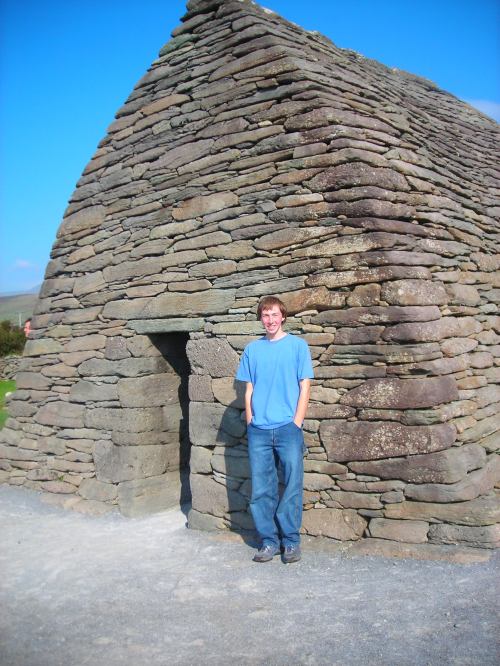
This little building stands alone in the Irish landscape. Notice how each stone had to be shaped to fit in with its neighbor.
The Oratory is over 1200 years old. The walls are 4 feet thick, and the individual stones lean outward to keep the rain out. After twelve centuries, the Oratory is still waterproof. The interior is tiny, compared to the relative size of the structure. I could probably lie down and touch both side walls. On the back wall is a tiny square window, aligned to catch the morning sun. In the window, people sometimes leave a few euro as an offering. I lost a lot of faith in humanity when one of our group found the little pile of coins and exclaimed excitedly “Hey look! Free money!” and grabbed them. I don’t think she understood the whole ‘church offering’ concept.
The next stop on the Dingle Peninsula were the Beehive Huts. These were small, domed dwellings that the reclusive Catholic monks lived in in the Dark Ages. Once again, all of the construction was made of unmortarted stones.
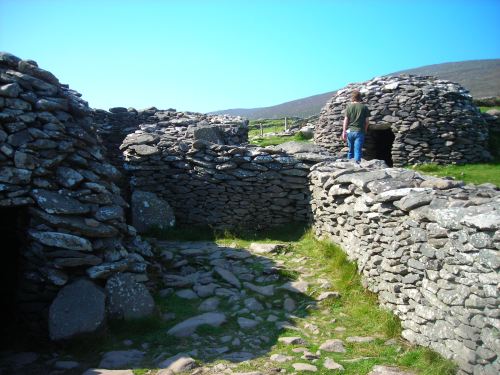
Unlike the much thicker Gallarus Oratory, these little huts are not even remotely waterproof. Those monks sure liked to suffer.
These early monasteries were elaborate. They actually have a system of narrow tunnels below, presumably for use during invasions. Unfortunately, this was the point in the trip where my camera began to die. I was okay with this though, becasue I had been carrying around a spare pair of double A’s in my pocket for two days, ready for this moment. I switched them out. They didn’t work. Uh oh.
Turns out, the batteries I was using were just too darned cheap to power something like a camera. Thus I was punished for my frugality, and I have very few photos of the rest of the trip.
Now, I’ve already mentioned that the roads in Ireland are very narrow. The reason for this is fairly obvious; Irish roads are plenty wide for a horse and carriage. Now, of course, there are a thousand tour buses on the roads in Ireland, and it’s something of a fiasco when a tour bus and another vehicle meet.
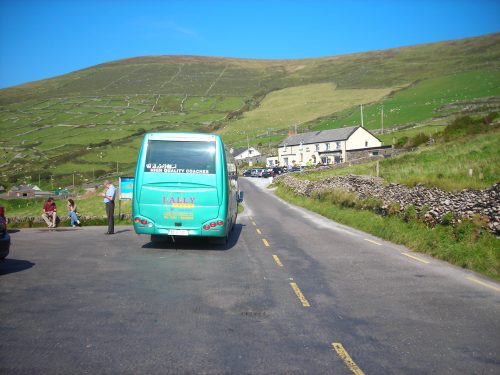
That's our tour bus. And right next to it is the road we were driving on. And that's not a one way street, folks.
Lets just say that there where a few times where I doubt I could have wedged three fingers in the space between the bus and the oncoming car. Our driver wasn’t much a tour guide, but you have to give him props for his driving.
Another attraction on the tour were the Blasket Islands. These are a chain of islands on the extreme southwestern tip of Ireland. As our bus driver put it: “Jump into the ocean and start swimming, and the next bit of land you’ll reach will be New York City.” We didn’t actually go to the islands at all -they’re quite uninhabited now-, we just got out and looked at them from across the bay. The word Blasket can perhaps translated from Norse to mean “Dangerous”, which would be rather fitting. It was here that dangerous currents destroyed a number of vessels in the Spanish Armada. These islands were also the subject of a certain amount of antropological study near the end of their inhabitence in the early 1950’s. Until 1953, the islands were populated by a few gaelic speaking people who upheld a very traditional way of life, uninfluenced by the outside world. Eventually, the young people realized that living a traditional way of life uninfluenced by the outside world sucks an awful lot, and they began to leave the island. Of course, this was the beginning of the end of the Blasket Island civilization, and in November 1953 the government evacuated the remaining 22 inhabitants.
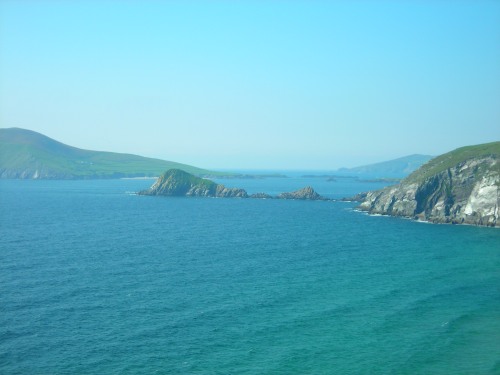
You can see one of the Blaskets on the left. The rock formation in the middle there is called "The Sleeping Giant". Can you see him? Hint: He has a really big belly.
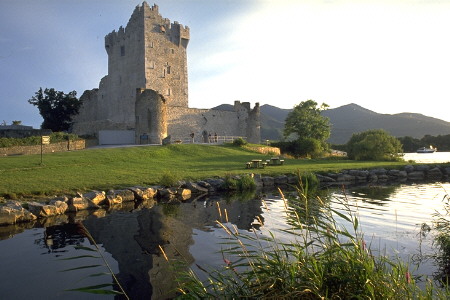
This is Ross Castle, courtesy of the Internet. When we were there, that lake was full of ducks, swans, and traditional wooden boats, adding to the idyllic feel.
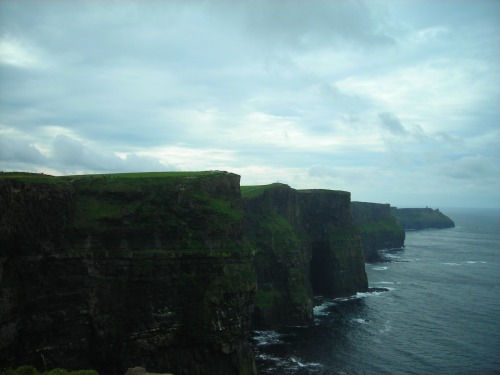

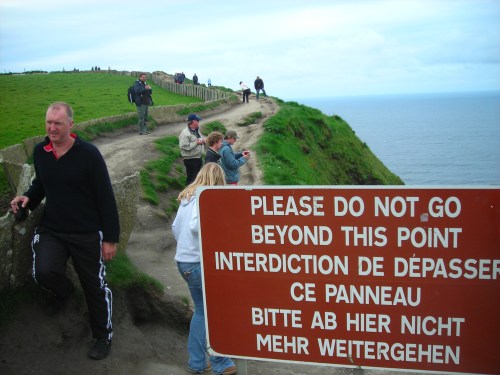
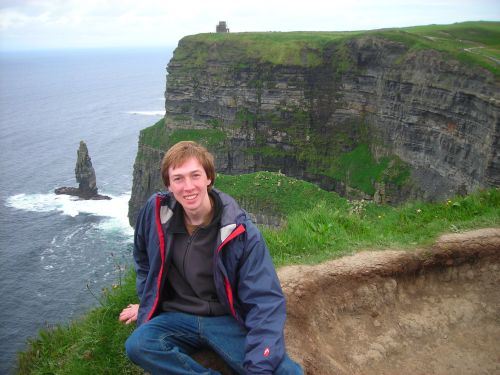
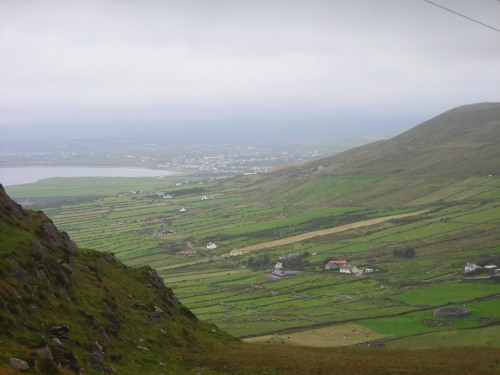
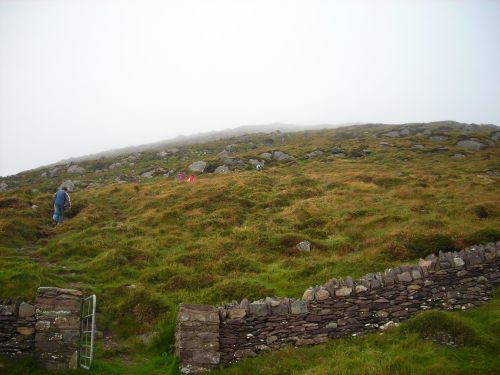
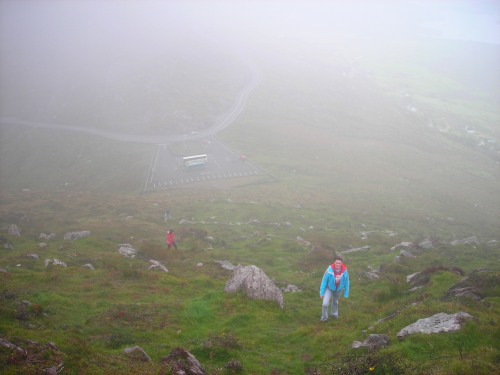
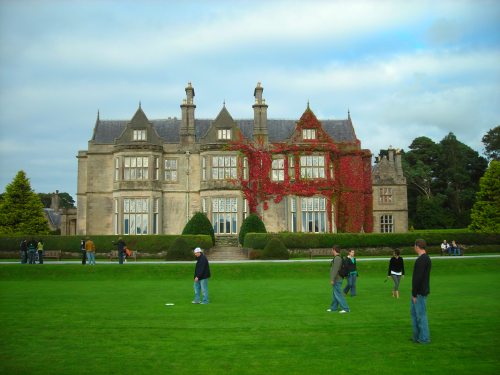
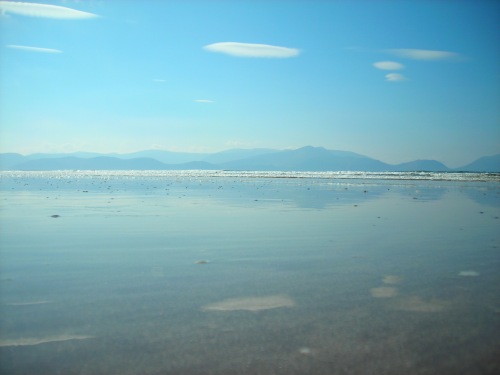


As I’m sure you all noticed, there are some weird boxes there in the end of the post. The reason for that is that WordPress doesn’t seem to like exceedingly long blog posts, so I had to jury rig some white spaces in there to take the place of paragraph breaks. Don’t worry, you’ll probably never see them again. I don’t want to make another blog post this long for quite some time.
By: spost on September 22, 2008
at 4:10 pm
bad boy! i’ll make sure mom sees the pictures of you on the cliff. foolish American. Looks like you’re having oodles of fun. i’m still amazed at how many pictures you’ve taken. Be sure to take a picture of a leprechaun holding my camera case or something 🙂
enjoy wherever you said you’re going next… Belfast. that’s it
By: Laura (Rat Girl, what have you) on September 22, 2008
at 5:26 pm
[…] https://spost.wordpress.com/2008/09/22/kerry-excursion/ If you liked this post then you may like this one […]
By: Bingo on September 23, 2008
at 9:00 pm